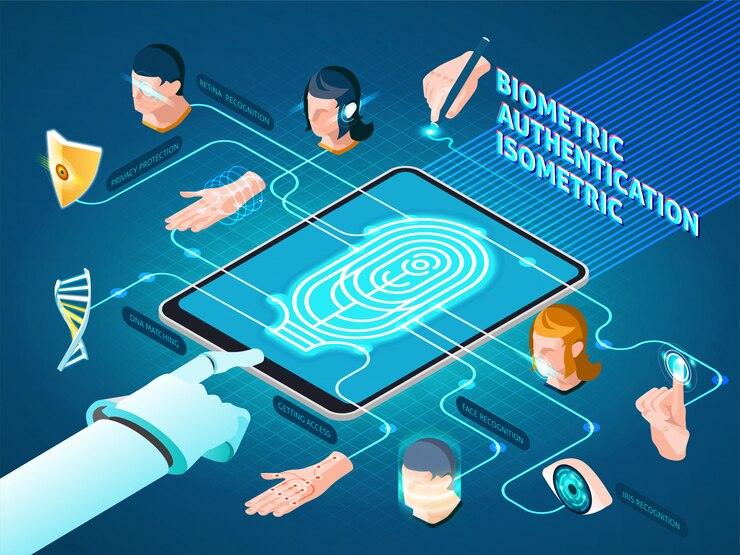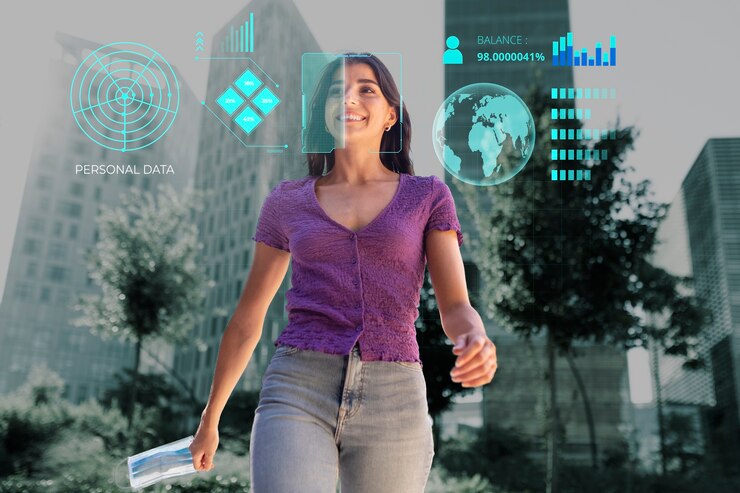The 4 main types of biometrics are fingerprint, facial recognition, iris scan, and voice recognition. These biometric technologies are used to identify individuals based on unique physical or behavioral traits.
Biometrics is a rapidly advancing field that has revolutionized the way organizations secure access and verify identities. Fingerprint recognition is one of the oldest and most widely used biometric methods, leveraging the unique patterns present on an individual’s fingertip. Facial recognition technology uses facial features to identify individuals, while iris scanning relies on the complex patterns in the iris of the eye.
Voice recognition utilizes an individual’s unique vocal characteristics for identification. The widespread adoption of biometrics has enhanced security measures in various industries, from law enforcement and border control to financial services and mobile devices.
Introduction To Biometrics
Biometrics refers to the use of unique physical characteristics for identification and authentication purposes. There are four main types of biometrics: fingerprint recognition, facial recognition, iris recognition, and voice recognition. These methods provide secure and efficient means of verifying an individual’s identity.
Definition And Importance Of Biometric Identification
Biometrics refers to the measurement and statistical analysis of people’s unique physical and behavioral characteristics. It is used to verify individuals’ identity through the collection and analysis of data. Biometric identification plays a crucial role in enhancing security, preventing identity fraud, and providing convenient access to various systems and services.
Brief History And Evolution Of Biometric Technology
Biometric technology has a long history dating back to ancient civilizations where physical characteristics were used for identification. The evolution of biometric technology has led to the development of sophisticated systems that can accurately recognize individuals based on their unique traits. From fingerprint recognition to facial recognition, biometric technology has made significant advancements, revolutionizing the way we authenticate identity.

Physiological Biometrics
Physiological biometrics are a type of biometric identification that uses the unique physical characteristics of an individual for authentication. These characteristics are inherent to an individual and include traits such as facial features, fingerprints, iris patterns, and retinal blood vessel patterns. Let’s delve into each of the primary physiological biometrics to understand their significance in identity authentication.
Facial Recognition
Facial recognition is a popular biometric technology that analyzes and identifies an individual’s facial features. This process involves capturing facial characteristics such as the distance between the eyes, nose, and mouth, and then converting them into a unique digital code for comparison and identification. The use of facial recognition has gained prominence in security systems, mobile devices, and law enforcement.
Fingerprint Recognition
Fingerprint recognition relies on the analysis of the unique patterns and ridges present on an individual’s fingertips. This biometric modality is widely used in access control systems, unlocking smartphones, and law enforcement databases due to the distinctiveness and reliability of fingerprints for identification.
Iris Recognition
Iris recognition involves using the intricate patterns present in the colored part of an individual’s eye, known as the iris, for identification purposes. The iris contains a complex and unique pattern that remains stable over time, making it a robust biometric identifier. This technology is employed in high-security applications, airport security, and access control systems.
Retina Scanning
Retina scanning, unlike iris recognition, examines the blood vessel patterns at the back of the eye for authentication. The retina patterns are considered to be highly unique to each individual, and the technology is utilized in high-security environments such as military installations and top-secret facilities to ensure stringent identity verification.
Behavioral Biometrics
Behavioral biometrics refer to the unique patterns and characteristics of an individual’s behavior which can be used for identification and authentication. This type of biometrics focuses on the distinctive way people speak, write, walk, and interact with devices. Here are some key forms of behavioral biometrics:
Voice Recognition
Voice recognition analyzes the unique aspects of an individual’s speech patterns, such as tone, pitch, and rhythm, to verify their identity. This technology is widely used in various applications, including voice-controlled devices and phone-based authentication services.
Typing Rhythm
Typing rhythm, also known as keystroke dynamics, involves the analysis of an individual’s typing patterns, including the speed and rhythm of their keystrokes. Organizations use this form of biometrics for secure user authentication and access control.
Gait Analysis
Gait analysis focuses on the unique walking patterns and movements of individuals. Advanced algorithms identify and measure specific traits, such as stride length and posture, to create a distinct gait signature, which can be used for identification purposes.
Signature Analysis
Signature analysis utilizes the unique characteristics of an individual’s handwriting to verify their identity. This form of biometrics is commonly used to authenticate signatures on documents and checks, offering a secure and reliable authentication method.
Biological Biometrics
Biological biometrics utilize physical characteristics such as fingerprints, facial recognition, iris scanning, and voice recognition to identify individuals. These unique traits provide secure and reliable authentication, making them ideal for identity verification in various applications.
Biological Biometrics
Biological biometrics refer to the use of unique physical characteristics of an individual for recognition and identification purposes. This approach leverages the distinct biological features and patterns that are specific to each person, making it a highly reliable form of biometric authentication.
DNA Matching
DNA matching involves comparing an individual’s DNA profile to a known genetic marker. It is a highly accurate form of biometric identification, as DNA is unique to each person, with the exception of identical twins.
Vein Pattern Recognition
Vein pattern recognition utilizes the distinct patterns of veins in an individual’s body, often in the hand or finger, to create a unique biometric identifier. The intricate network of veins provides a highly secure form of biometric authentication.
Earlobe Geometry
Earlobe geometry involves the measurement and analysis of the size, shape, and unique contours of an individual’s earlobe. This method is gaining popularity as a reliable biometric identification technique due to the distinctive nature of earlobe features.
Hand Geometry
Hand geometry focuses on the study of an individual’s hand proportions, including the length, width, and curvature of fingers, as well as the geometry of the palm. This form of biometric authentication is widely used in access control and time attendance systems due to its reliability and convenience.
Biological biometrics offers a diverse range of identification methods that are highly accurate, consistent, and difficult to replicate. The unique biological characteristics used for biometric identification provide a robust and secure approach to verification and authentication.
Multimodal Biometrics
Multimodal biometrics refers to the combined use of different biometric modalities to enhance the accuracy and reliability of identity verification systems. By integrating multiple biometric identifiers, such as fingerprints, facial recognition, iris scans, and voice recognition, multimodal biometrics offer a more robust and secure approach to identity authentication.
Combined Use Of Different Biometric Modalities
Multimodal biometrics leverages the strength of multiple biometric identifiers, creating a more comprehensive and accurate representation of an individual’s identity. By combining modalities such as fingerprints, facial features, iris patterns, and voiceprints, the system can mitigate the limitations of individual biometric methods, thereby enhancing overall accuracy and reducing the likelihood of false positives or false negatives.
Advantages And Applications Of Multimodal Biometrics
- Improved accuracy and reliability: The integration of multiple biometric identifiers enhances the robustness of identity verification, reducing the risk of unauthorized access and fraudulent activities.
- Enhanced security: Multimodal biometrics provides a higher level of security as it requires the simultaneous validation of multiple biometric traits, making it more difficult for unauthorized individuals to bypass the system.
- Diverse applications: This technology finds applications in various sectors including law enforcement, border control, financial services, healthcare, and access control systems where heightened security is essential.
Potential Challenges And Future Developments
While multimodal biometrics offer significant advantages, challenges such as integration complexities, cost, and privacy concerns need to be addressed. Future developments may focus on improving user experience, reducing hardware costs, and addressing privacy regulations to ensure widespread adoption and acceptance of multimodal biometric systems.
Frequently Asked Questions For What Are The 4 Main Types Of Biometrics?
What Are 3 Commonly Used Biometric Security Features?
Commonly used biometric security features include fingerprint scanning, facial recognition, and iris scanning. These technologies accurately identify and authenticate individuals.
What Are The 5 Biometric Types That Can Be Used To Authenticate A Person?
The 5 biometric types used for authentication are fingerprint, facial recognition, iris scan, voice recognition, and hand geometry.
What Is The Strongest Form Of Biometrics?
Fingerprint recognition is the strongest form of biometrics due to its high accuracy and uniqueness. It is commonly used in various security systems.
What Are The Three Most Accurate Biometrics?
The three most accurate biometrics are fingerprint, iris, and facial recognition. These biometric methods provide reliable and secure identification. Their unique features make them highly accurate for verifying individuals’ identities.
Conclusion
Biometrics technology is constantly evolving, offering various types with unique features. Understanding the four main types of biometrics is vital for businesses and individuals alike. From fingerprints to facial recognition, each type offers its own set of advantages and applications.
As biometrics continue to advance, it’s clear that they will play a crucial role in shaping our future.

